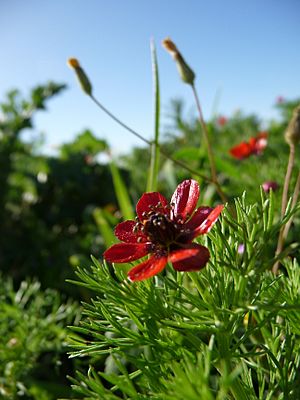Seed plants facts for kids
Seed plants are a big group of plants that make seeds. These seeds help them reproduce and grow new plants. The two main types of seed plants are Gymnosperms and angiosperms. You can find seed plants almost everywhere on land, from forests to deserts!
A seed has three important parts:
- An embryo: This is like a tiny baby plant inside the seed.
- A supply of nutrients: This food helps the baby plant start growing.
- A seed coat: This protects the embryo and its food.
Seed plants are also called spermatophytes or phanerogams. They are very successful and grow in almost all land environments.
Contents
Types of Seed Plants
There are five main groups of living seed plants today. Each group has unique features.
Cycads
Cycads are plants that look a bit like palm trees or ferns. They grow in warm, tropical, and subtropical areas. They have a thick trunk and a large crown of leaves.
Ginkgo
There is only one living species of Ginkgo tree left today. It is a very old type of tree, often called a "living fossil."
Conifers
Conifers are trees and shrubs that produce cones. Think of pine trees, fir trees, and spruces. Many conifers have needle-like leaves and stay green all year round.
Gnetophytes
Gnetophyta is a small group of woody plants. It includes interesting plants like Gnetum, Welwitschia, and Ephedra. They have some features that are similar to both conifers and flowering plants.
Flowering Plants
Angiosperms are the flowering plants. This is the largest group of seed plants. It includes many plants you know, like roses, apples, and grasses. They grow in many different places around the world.
History of Seed Plants
Seed plants have been on Earth for a very long time.
Early Seed Plants
The fossil seed ferns (Pteridospermatophyta) were some of the first successful land plants. Forests full of seed ferns were common during the Permian period. This was a long time ago, even before the dinosaurs!
Ancient Trees
Glossopteris was a very important tree genus (a group of related species) in the ancient southern supercontinent of Gondwana. It lived during the Permian period.
Modern Seed Plants Emerge
By the Triassic period, seed ferns became less common. Modern gymnosperm groups, like conifers, became very common. They were the main type of plant until the Upper Cretaceous period. That's when flowering plants (angiosperms) started to grow and spread rapidly. This rapid growth is called adaptive radiation.
Related pages
See also
 In Spanish: Espermatofitas para niños
In Spanish: Espermatofitas para niños


